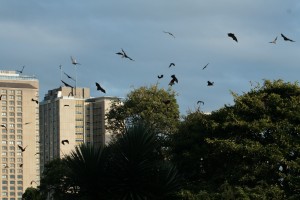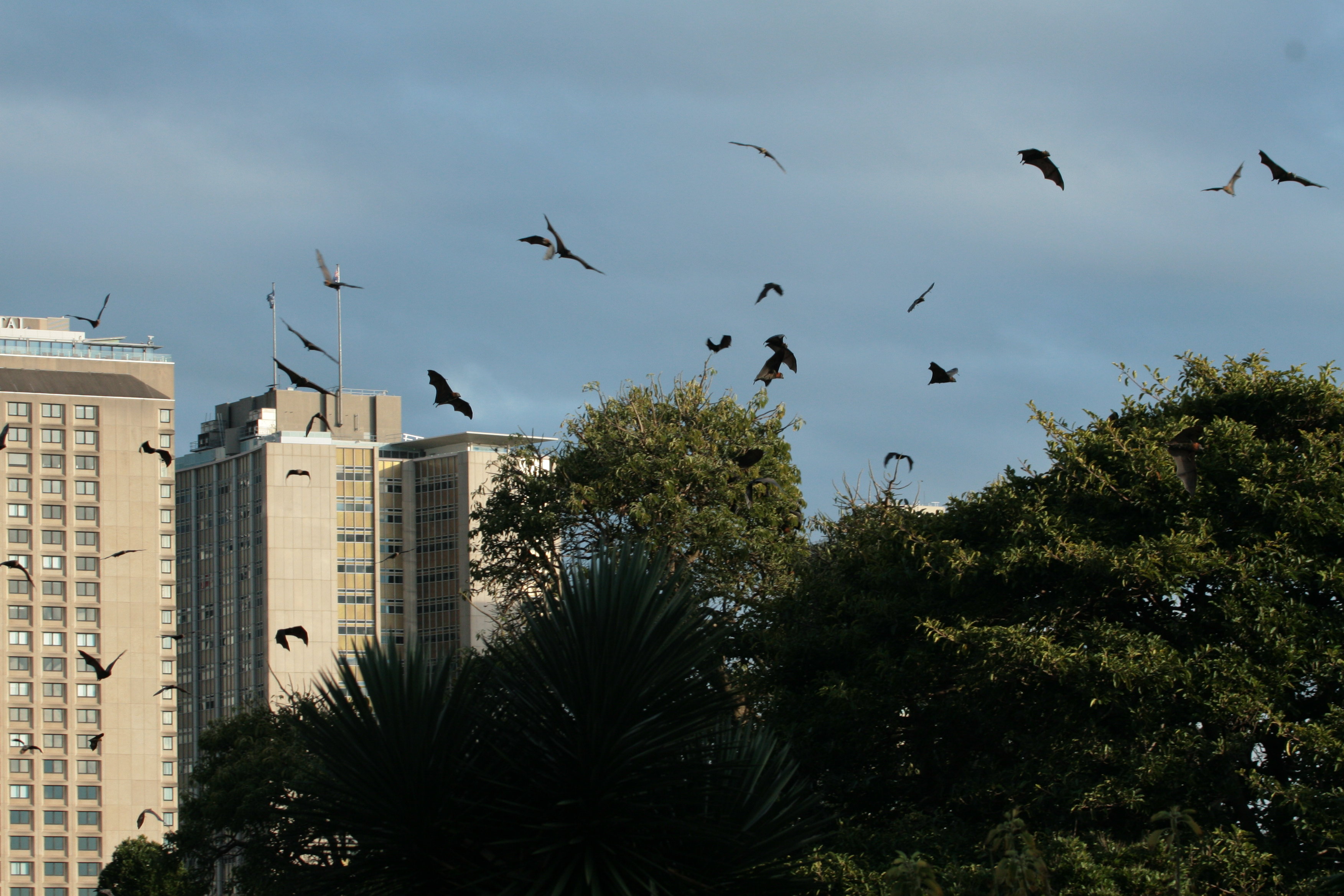Night falls heavily in Sydney these days
Two years ago I began investigating flying foxes and the people who rescue, foster, and rehabilitate them, and serve as their advocates. I didn’t (or couldn’t) imagine that Sydney’s Royal Botanic Gardens’ proposal to expel the flying foxes would be given ministerial approval. However, the programme of intense harassment, designed to protect heritage trees in which flying foxes were camping by forcing the animals out, was approved. Animal ethics protocols were established, and a costly program of monitoring was implemented. Co-existence didn’t seem to be a scenario the Garden was remotely prepared to consider.
In June 2010 my colleague Natasha Fijn joined me to make a video about flying foxes in Australia. In one segment, scientist and activist Tim Pearson took us for a walk through the Garden and discussed the lives of flying foxes, plans for the ‘dispersal’ (expulsion), and measures in place to monitor the process. The video shows what was then a lively conviviality between flying foxes, the garden, and visitors. Retrospectively, buy custom papers looks like a glimpse into Eden.
Two years later, on 4 June, shortly before the rise of a stunningly bright full moon, the harassment began. Later there was a lunar eclipse, and it seemed burdened with significance, as if the glory of the moon were being overtaken by darkness to parallel this cruel expulsion.
Australia has known many dispersals. In the days of conquest, the term was a euphemism for killing Aboriginal people. These days it still seems to convey an intention to disguise something awful. And there can be no doubt that what the flying foxes are being subjected to amounts to terror. That is the point. They wouldn’t leave otherwise. Looking at action rather than words, the programme seems to embody these ideas:
- Zero tolerance: there can be no accommodation between heritage trees and flying foxes
- Zero compassion: never mind that the females are in the first trimester of pregnancy, and are now being subjected to enormous and on-going stress, and that is a maternity camp to which they intend to return
- Zero planning: no one knows, and no one can know, where the flying foxes will go next, but almost every Sydney option is worse than where they are now. As long as food in the bush is scarce, groups will remain in Sydney, camping where conditions are good for them. Given the density of Sydney’s human population, it is extremely unlikely that they will settle in a place where nobody (human) notices and nobody (human) objects
- Zero time limits: The dispersal could keep going on for another twenty-seven years, generating unimaginable intergenerational catastrophe for flying foxes
- Zero bottom line: the cost of expelling the flying foxes is far greater than the costs of putting in infrastructure that would enable peaceful co-existence to continue
- Zero connectivity: the RGB mentions the damage done to heritage trees, but says little of the role of flying foxes in pollination and seed dispersal throughout vast regions of Australia. In forcing the story into an either-or frame (either trees or flying foxes) the opportunity is lost to take significant educational steps toward ecological literacy and practice
- Zero awe: it is hard for me to imagine, but apparently some people are immune to the beauty and mystery of these creatures. Every night around sunset the flying foxes start their nightly flyout. With their dark fur, their wing spans of up to one meter, and their distinctive bat silhouette, they stand out against the clear colours of a Sydney sunset. They fan out across the Opera House, and over the Harbour Bridge. One can sit at Circular Quay, sipping a drink and watching the ferries, the bridge, and the lights of Luna Park flashing across the harbour. Then the motion above begins. Looking up into that blizzard of flying foxes, one feels quite close to paradise.
How dismal it is that the challenge of working out forms of co-existence that would enable the flying foxes and the RBG’s exotic trees to live together has been overwhelmingly shirked. And how dismal that it is actually professionals at the RBG who are harassing the key pollinators and seed dispersers for rainforests and woodlands.
How beautiful it could have been, and still could be:
- net the affected trees and bring in new trees so that flying foxes will have a safe place to camp,
- make a feature of the multispecies, multigenerational, multipurpose Botanic Gardens,
- educate the public on plant ecology and the significance of this keystone species,
- protect numerous threatened species, flora and fauna,
- set leadership standards for how flying foxes, trees and people can share their lives to everyone’s benefit, and enable visitors and locals alike to revel in the joy of the flyout across the harbour.
As another dark night settles over this Garden that has become a place of torment, I want to keep remembering the joy of life: flying foxes want to live their lives in their own way, and we humans can take great pleasure in that. In journalist James Woodford’s words: ‘watching bats silhouetted against the stars is one of the greatest, but little known, pleasures of life’.
While we are remembering the fundamentals of life, including joy, conviviality, and generosity, let us remember as well this fundamental truth concerning vilification: neither trees, nor flying foxes, nor people, nor the future, can benefit in the long run from violence and trauma. The hard-heartedness that rejects conviviality in favour of war leaves disaster in its wake.

Deborah Rose
10 June 2012

I was shocked last year, on returning to Melbourne, to find they’d expelled the flying foxes from Melbourne Botanical Gardens. The park-keeper was blase about it, and simply said people didn’t like their smell.